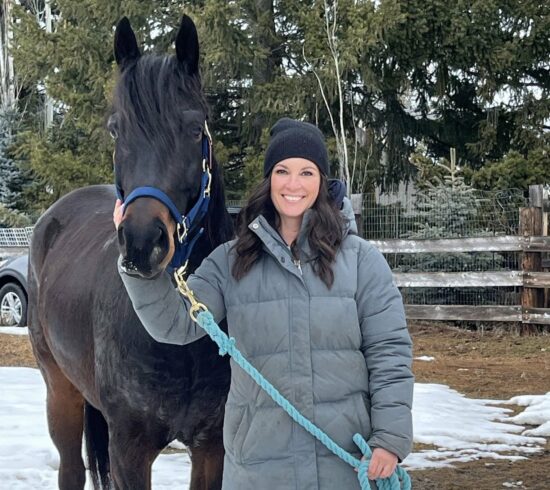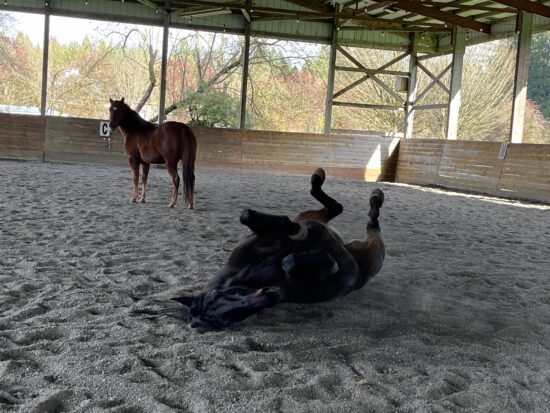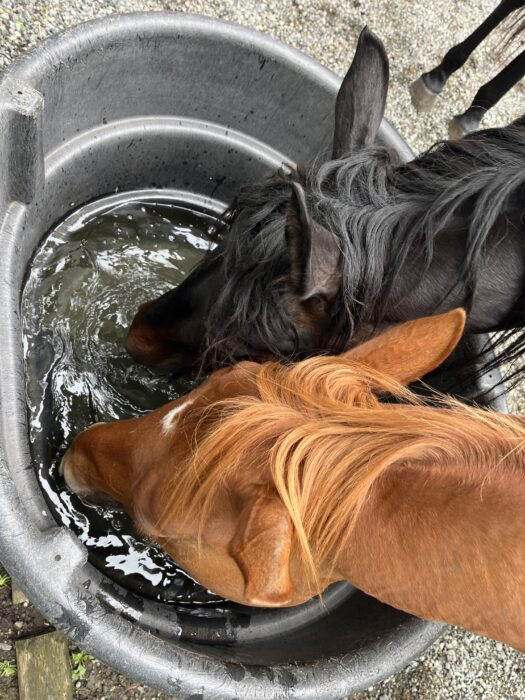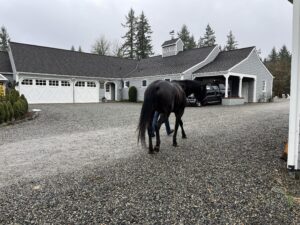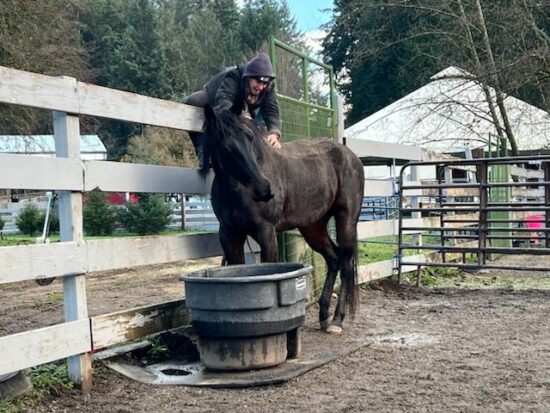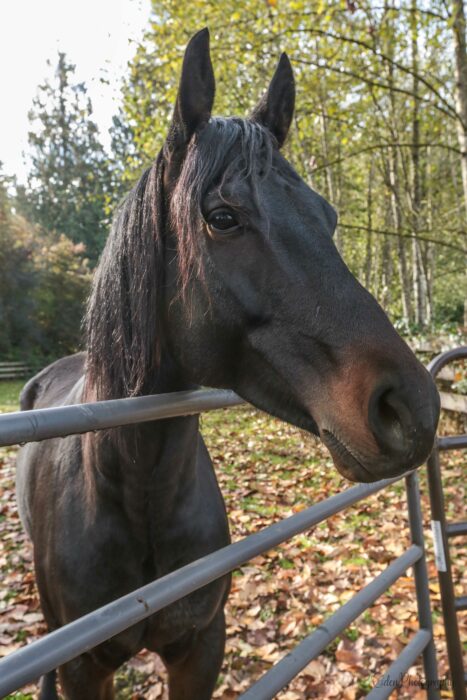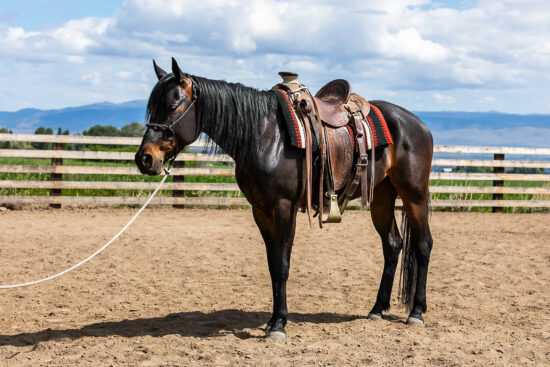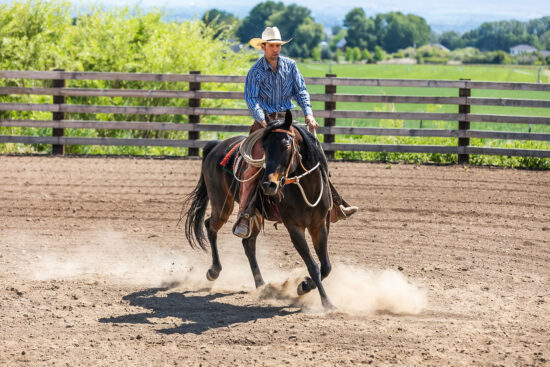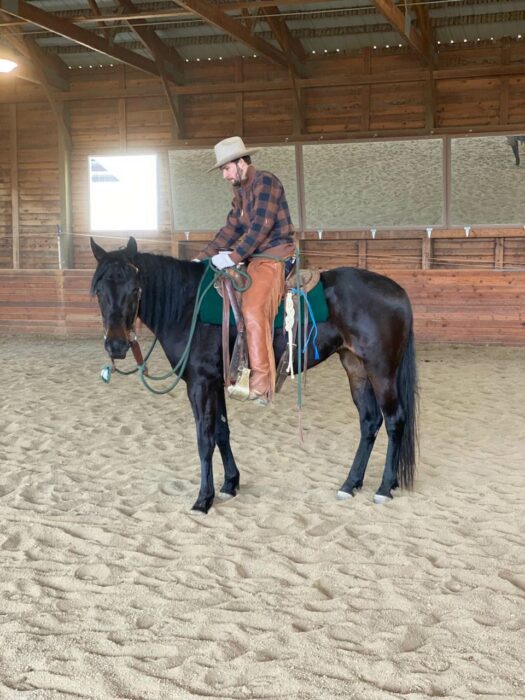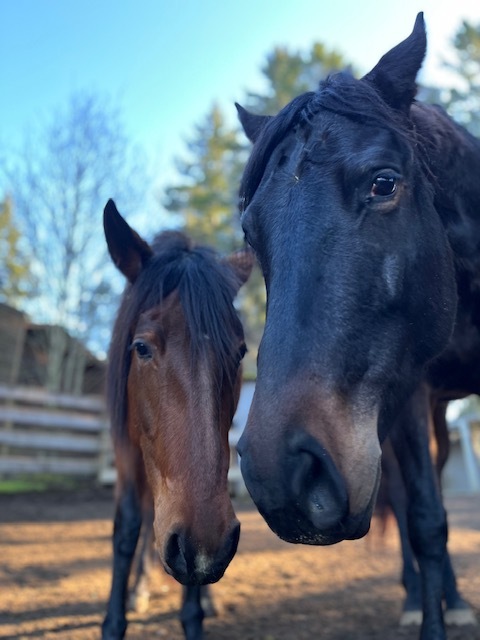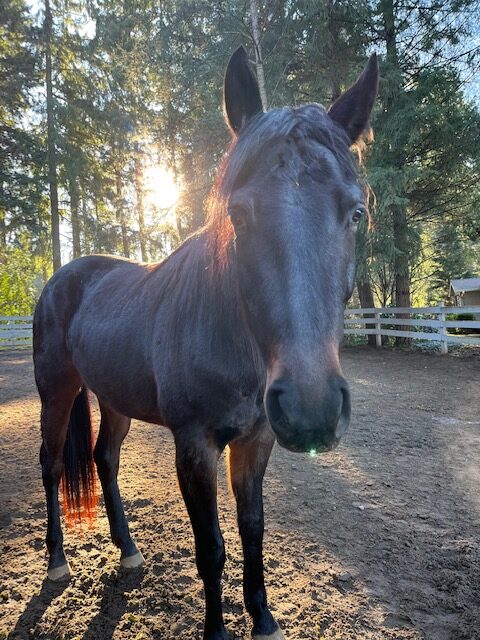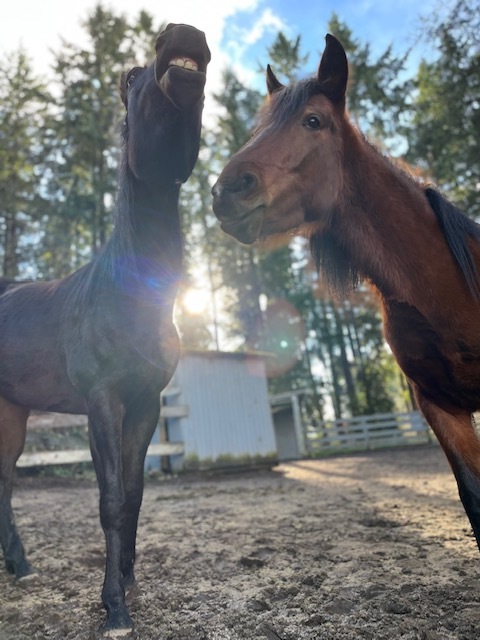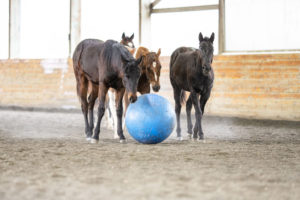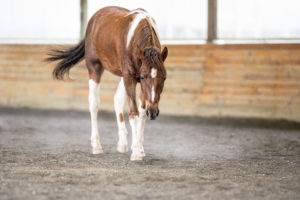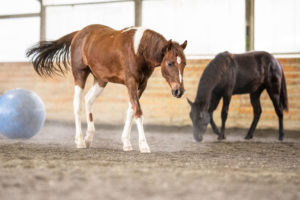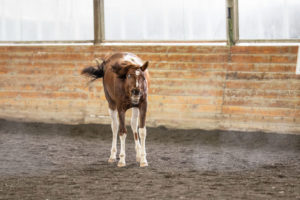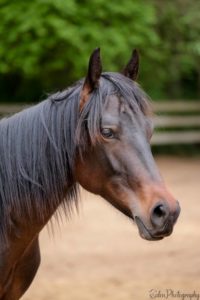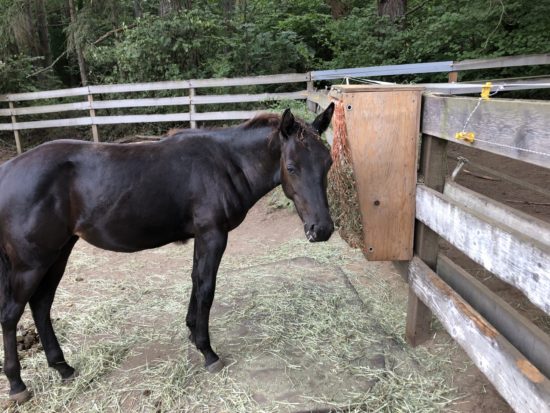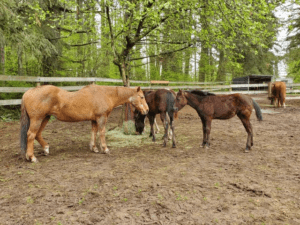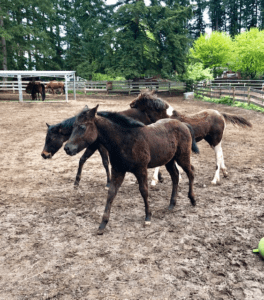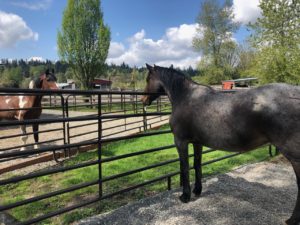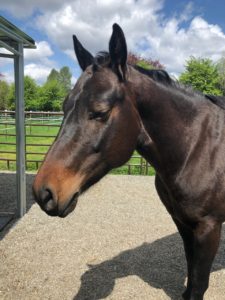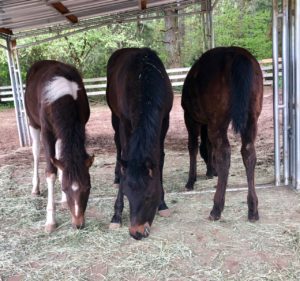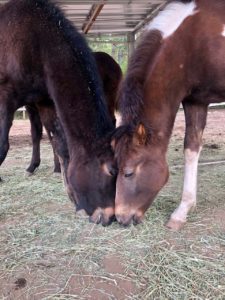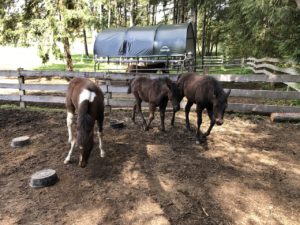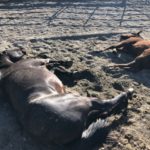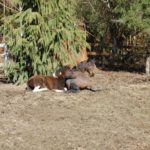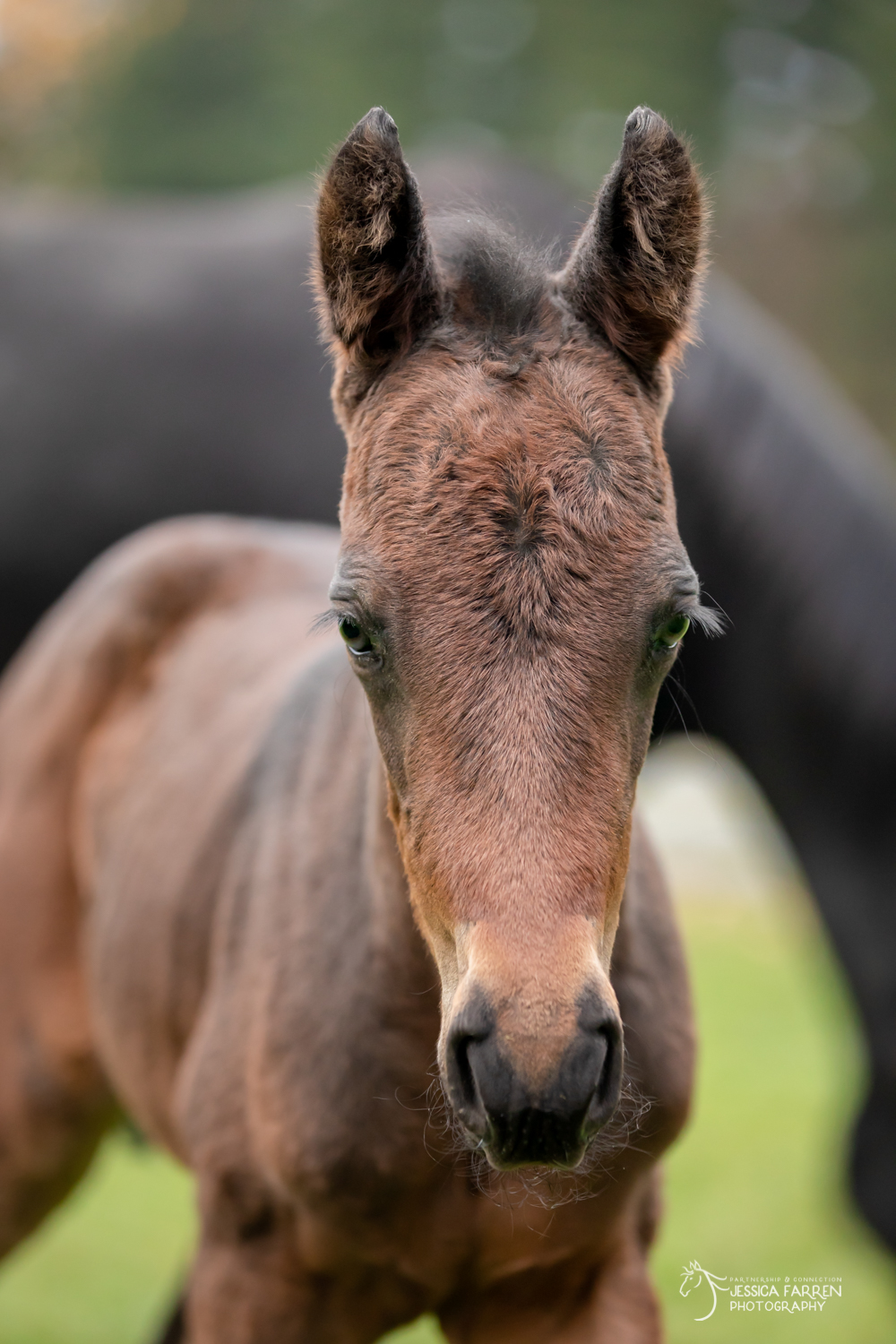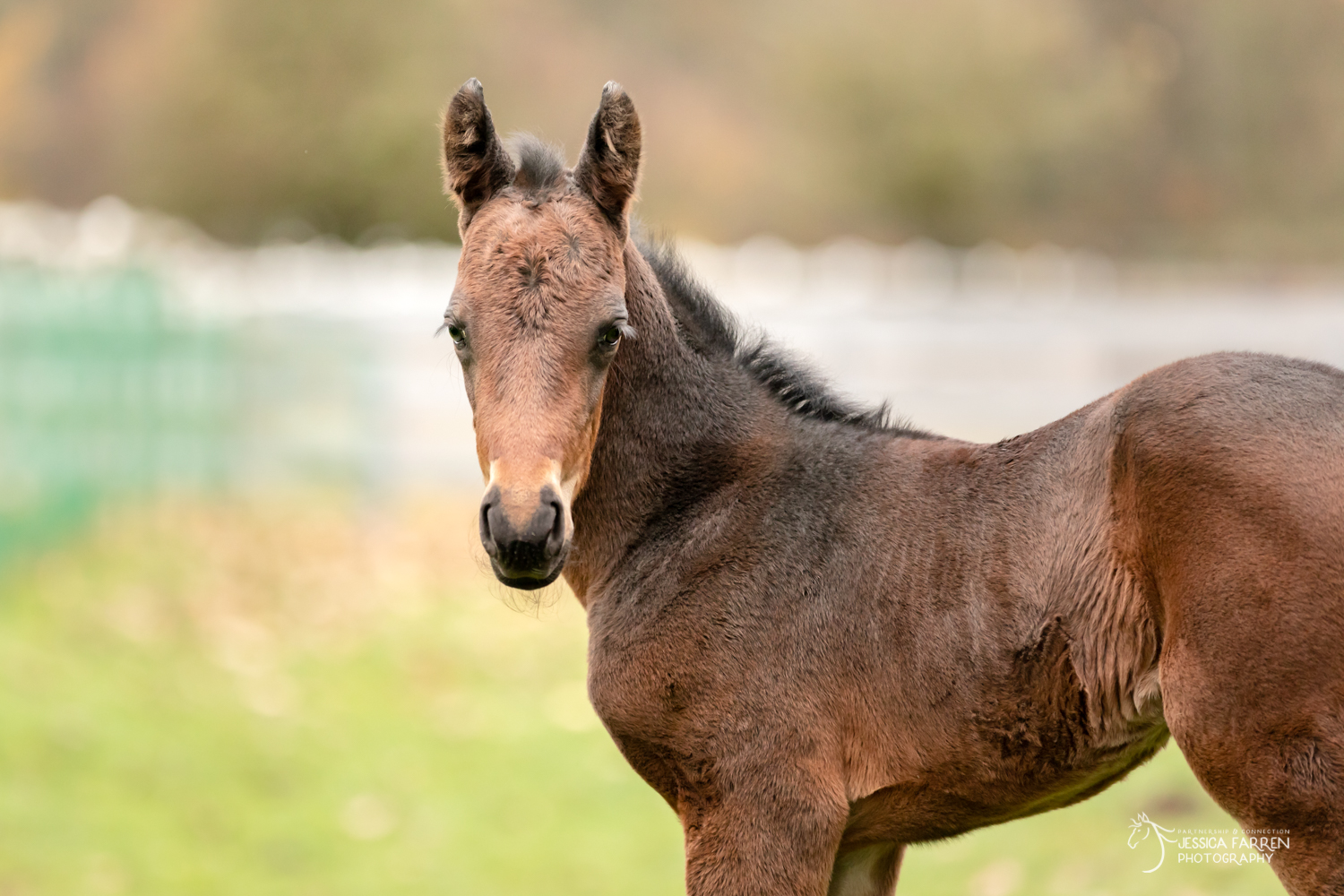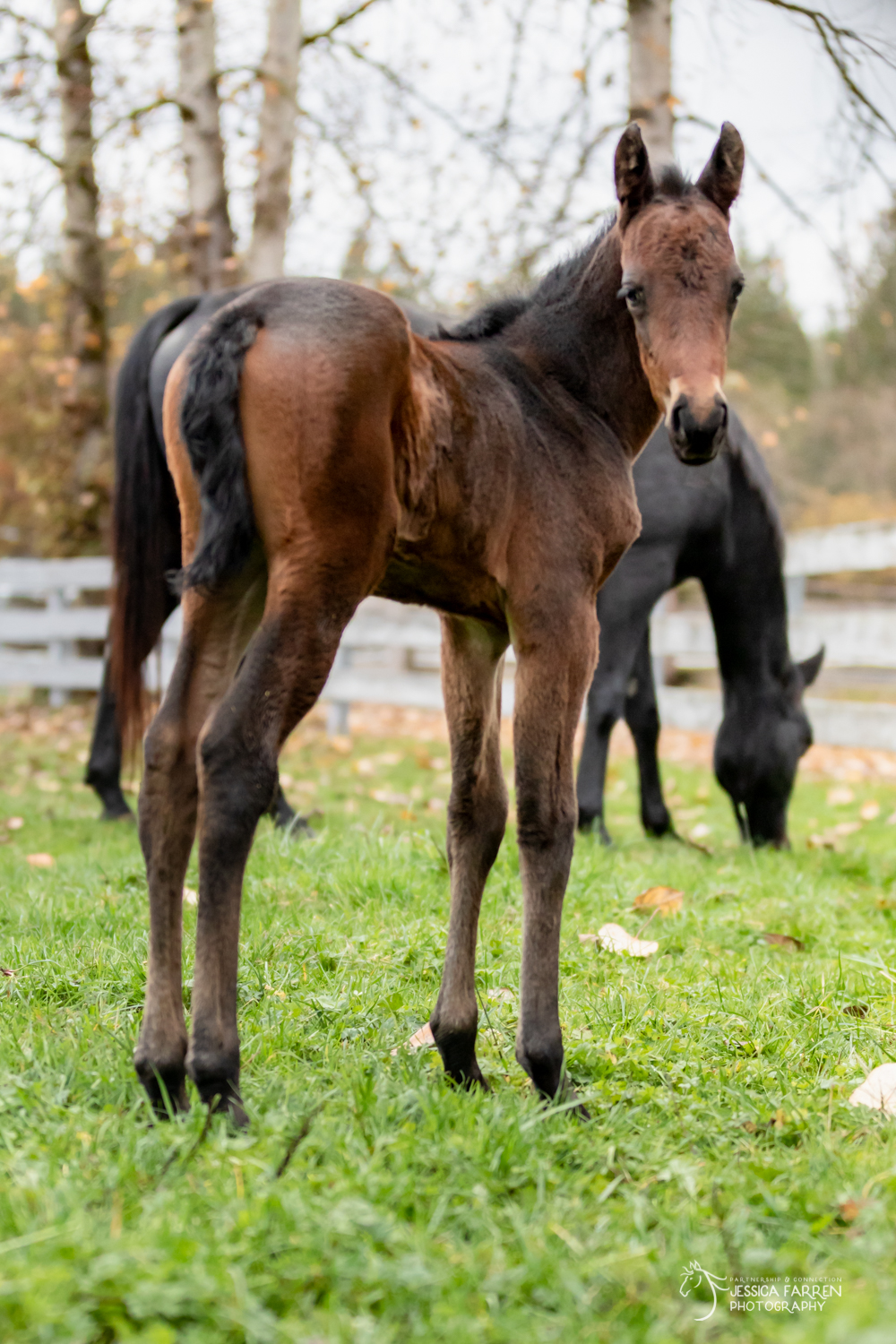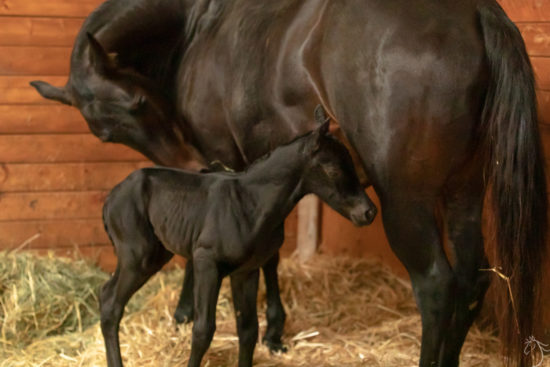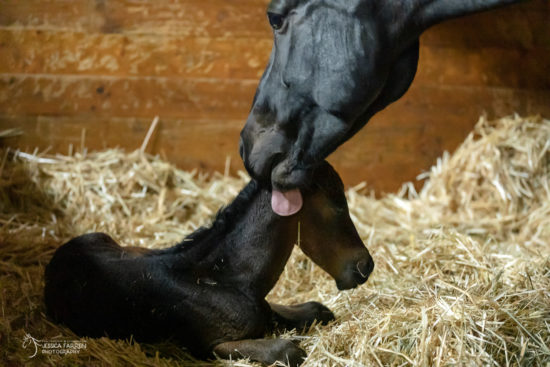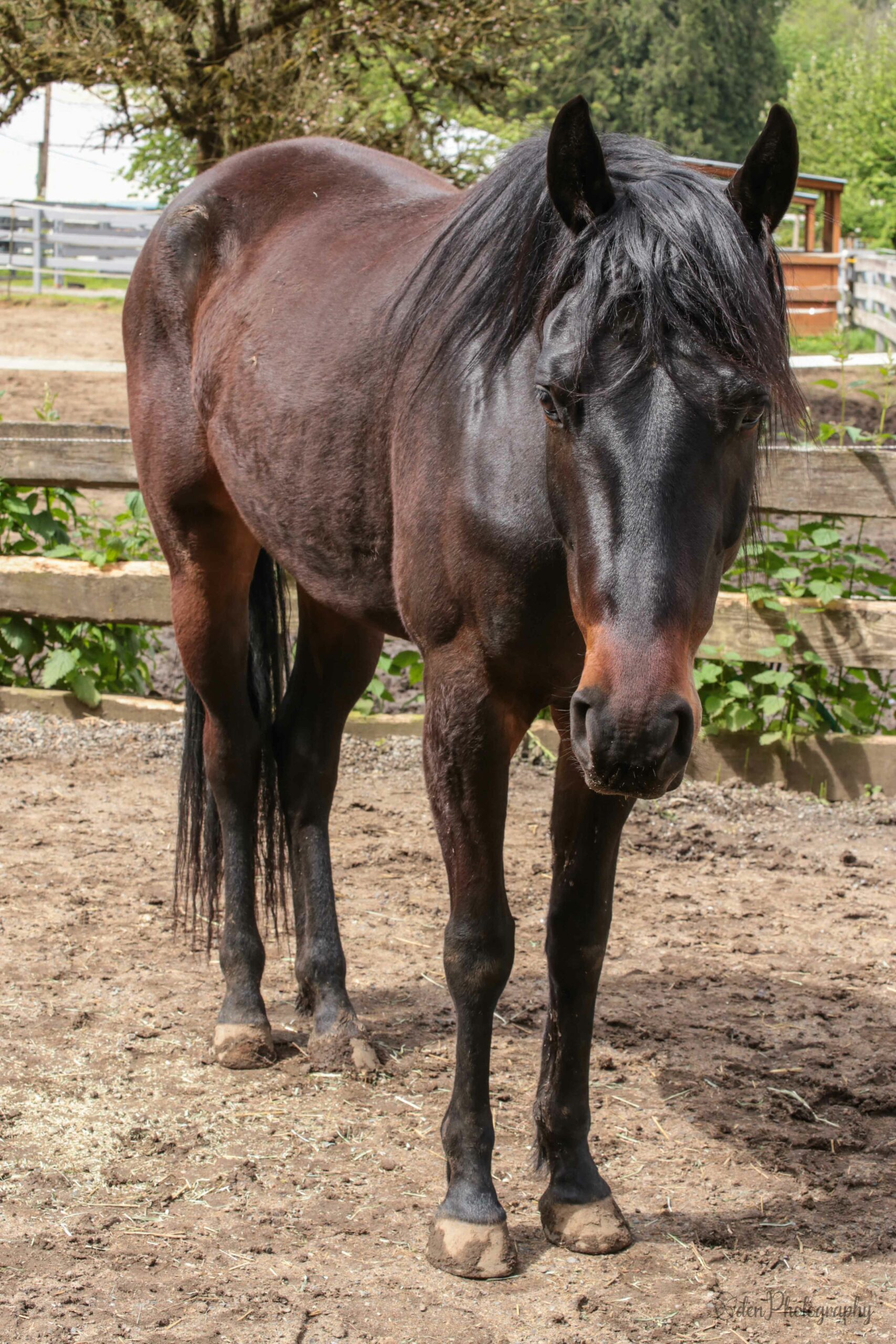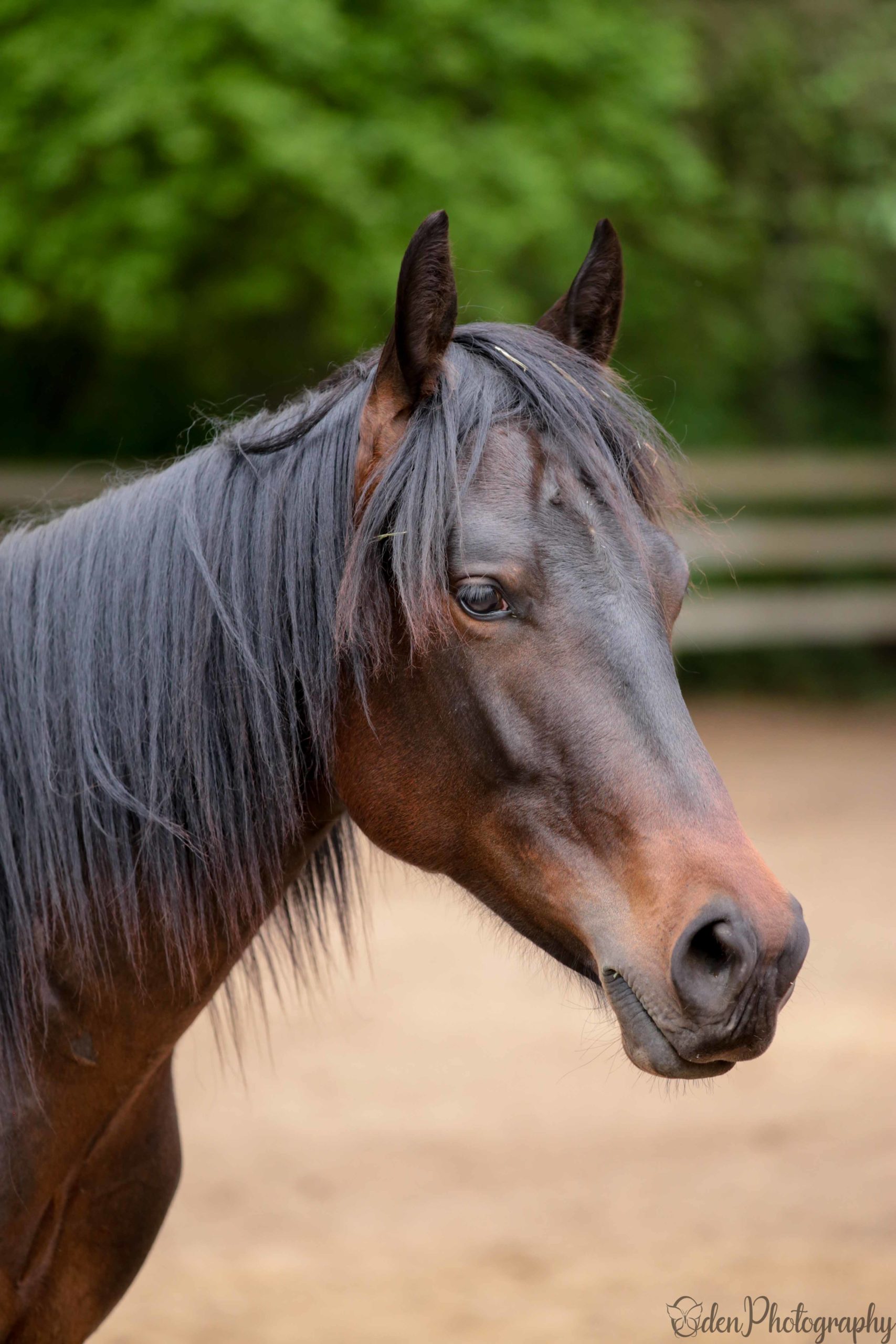Nova
2018 Warmblood type mare
Suitability: For Advanced Handler
Color: dark bay
DOB: 11/3/2018
Height: 15.2 hh
Weight: 900 lbs
Adoption Fee: $3,000 (will increase with training)
Nova was the third filly born at SAFE Harbor in 2018. She’s a stunning filly who looks a lot like her dam Luna and definitely takes after her mom with her long legs! Nova was started under saddle in 2021, and was ridden regularly since turning four years old.
Due to an increase in hormonal-related behavioral issues, Nova was spayed at the beginning of 2024, and was given ample time off to recover from the surgery and to allow her hormone levels to stabilize. In the fall of 2024, Nova returned to some light work. We are taking things nice and easy with this girl as we begin her restart into life as a working horse.
All SAFE horses are adopted with a no-breeding clause, no exceptions.

Nova Goes to Foster
Nova has had enough of this rain and Western Washington Weather –— she has temporarily relocated to the East Side to foster with Blair, Bijou, and Bear. Blair’s ‘R&B Ranch’ is already known to us as a phenomenal place to spend time (just asked Bijou, who loved it so much she moved in permanently!) so we are incredibly grateful to Blair for opening up her home to another SAFE horse. Nova has a large space to herself, plus an even bigger turnout with her new friends.

Rediscovering Nova: A Journey Beyond Hormones
It’s time for a long-overdue update on our mare, Nova! This summer, Nova has enjoyed a growing friendship with Harissa. They make a great pair, with Harissa helping to keep Nova grounded when she gets a little too bold. Overall, Nova has shown significant improvements in her behavior during day-to-day care, and we’re thrilled to see her back to being the mare we knew before hormonal shifts impacted her demeanor.
We prioritized giving Nova time to settle into her “new normal” post-surgery, allowing her to naturally adjust without the influence of hormones. It’s similar to how an older stallion might need time to mellow out after gelding. This approach allowed us to understand her true personality before introducing any new challenges.
Previously, Nova had become so reactive that she was virtually untouchable. Haltering her became impossible without triggering intense reactions—she would scream, pee, and strike out. Since her spay surgery, she has become much more manageable with routine tasks like haltering, leading, grooming, and vet or farrier care. However, she’s still an independent spirit, and we respect her limits, asking nothing she isn’t comfortable with. When things don’t go her way, Nova can be pushy and requires an experienced handler.
At six years old, Nova has some riding experience, but she’s had a year off to allow for her surgery and recovery. She’s now ready to start a gentle reintroduction to riding. Restarting her will require a handler skilled in managing behavioral challenges, someone who can confidently encourage her cooperation and set clear expectations. As a naturally assertive horse, her training may not be without its challenges, but we’re optimistic.
Our current goal is to bring Nova back into riding condition so that she’ll be ready when the right horseman is available to work with her. In the meantime, she’s enjoying 24/7 access to a large dry lot and daily turnout in a big grass pasture—what she surely considers “horse heaven” at SAFE. Nova’s life here is indeed very good!

Nova’s Hoof Trim
One of the first warning signs that something was different about Nova back before her spay was her sudden inability to have her hooves trimmed. She had been seeing the farrier every 6 weeks for years, but one day she could not handle the touch of a familiar hand on her hind leg — anywhere behind her withers, really. Even the lightest of touches would cause her to squeal and kick and become quite dangerous to those handling her. After her spay, we gave Nova a bit of time off from asking anything of her, including having her hooves worked on, as she rested and recuperated. As she healed, many signs pointed towards Nova feeling a whole lot more herself — she certainly didn’t seem as finicky and reactive as she had back when she still had ovaries — but a true test would be how she reacted to the farrier. With her first post-spay farrier appointment in the books, we held our breaths and crossed our fingers in the hopes that she would be back to the Nova of old.
And indeed, she was a perfect lady for her hoof trim. She had no untoward reactions to having her legs handled, even the hind ones, and gave the farrier no trouble. In fact, she seemed to enjoy her pedicure, and all of the subsequent pets she received for standing so well.
This was not a one-off. Each trim since the spay has seen a well-mannered and polite Nova, fine with any stray brushes of a head or hand against her flank as her hooves are lifted and rasped. Clearly she is feeling a whole lot better, and so are we in the knowledge that we no longer have to delay her basic care for fear of injuring the carers!

Gals Being Pals
Nova and Harissa have been sharing a fence line for a while now, but recently became officially introduced out in their grass backyard. Neither of these girls are a stranger to herd dynamics, so there was very little fanfare as they established the hierarchy (Harissa > Nova), and ever since have been two little peas in a pod. Nova finally has a reliable companion to itch her withers, and Harissa gets a friend to horse around with, pun intended. We love new friends, and these two ladies are no exception!
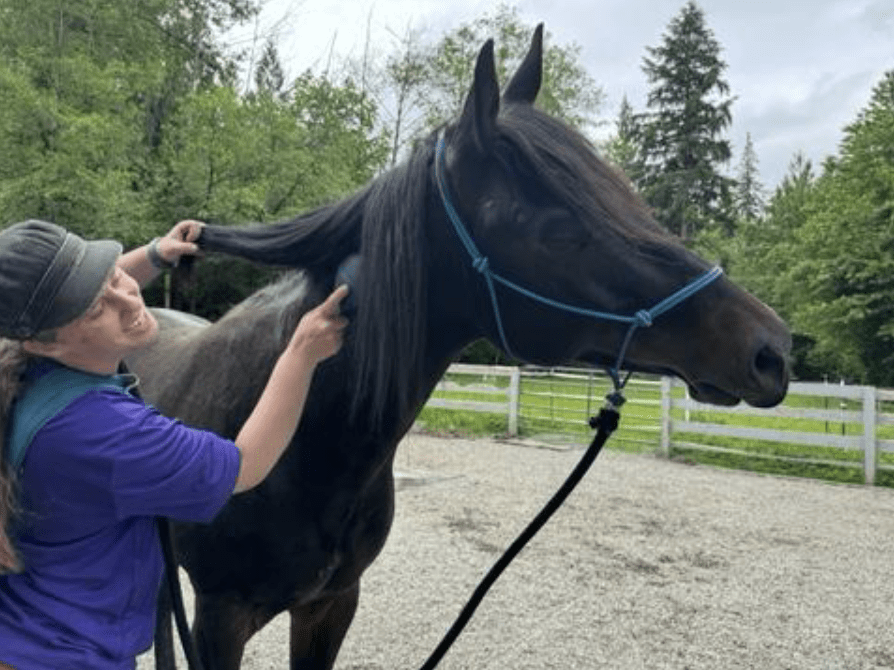
Nova’s Saturday Scratches
Trudy M, our stupendous Saturday barn staff, has been spending some time grooming Nova during the past few months while she has been in recovery from her spay earlier this year. We have given Nova some time off, and while her expectations for work have been low, she has still been getting her itches scratched with Trudy’s help. Here is what Trudy has to say about Nova and their time together:
“Have you ever met a horse that captivated you from first glance? Where you can’t take your eyes off them when they move out freely in a field and you look forward to every small interaction with them? That is Nova for me.
I met Nova three and a half years ago when she was still being referred to as one of ‘the fillies’. She has outgrown that title long ago now, as a well grown, long-legged and muscular mare, who I once watched clear a six-foot wide bank of tires to reach the hay bag she wanted most, because going around is for wimps. This spring, Nova has been recovering from surgery. Each weekend, I’ve offered to ease her recovery with a few choice scratches. This girl cannot resist a good scratching.
As she has physically recovered from her spay surgery, we have been watching carefully to see how she would recover emotionally. Would we get to see more of that sweet Nova we remembered from before her cycles began? Would her volcanic moods even out without her brain being repeatedly flooded with intense bursts of hormones? So far, so good. She is no longer striking out at the slightest touch. Women who’ve had a particularly intense cycle and whole body wrenching cramps may be able to relate to how a light touch in those moments can feel like the jab of a hot poker. Nova is beginning to remember that touch can be very pleasant.
She has eagerly accepted grooming from nose to tail, leaning into the particularly itchy spots under her mane, between her front legs and along her back. If I’m scratching just right, she’ll even bend her long neck around my body and gently massage me with her lips, just as she might with another horse in a herd.
She contorts her body to press into the brush. Nova is not a fan of light touch, she’s more of a deep pressure kind of gal. She likes to be brushed firmly, to really feel the bristles through her coat. If I find just the right spot and brush just the right way, she makes the most ridiculous faces.
- Getting close…
- Closer.…
- There’s the face!
”

Nova’s Spay
Nova’s journey from foal to adulthood has been a tumultuous one to say the least. She was a delightful and friendly girl for the first two years of her life…but then we started to see changes. Her heat cycles, which started out normal, became problematic. She began to exhibit more and more hormonal behavior, and as she got older, she started to show worrisome signs of aggression, What made Nova’s situation so challenging to manage was the unpredictability of it all, her lightning-fast switch from docile to dangerous. While it was difficult not to rule out behavioral components entirely, the suddenness of her transformation made it seem more physiological than anything.
We tested Nova’s hormone levels in the fall, and while there was a slight elevation in her testosterone, it was back within the (higher end) of normal range by spring. We ran other bloodwork to check for granulosa cell tumors — no evidence. We ultrasounded her ovaries, and while one was larger than the other, there was nothing that stood out to the vets as a clear-cut issue. We started Nova on Regumate — first 10mls, then 15, then up to 20. We had her on first Mare Magic, then magnesium, both known for their calming properties. Nothing made much of a dent in her behavior. While she did have some ‘good’ days during the fall months, a return to form of the sweet Nova we knew and loved, from one day to the next she could morph into a horse we didn’t recognize. After additional consultation with our vets, and feeling like we had exhausted our non-invasive options to help Nova, we decided to set a date for a spay.
Spaying a mare is not a common practice, as it is more intensive and specialized than a gelding surgery. With geldings, we have the option to perform them on site here at SAFE — such a thing is not possible for a spay. In addition, because it is not routinely done, not every vet can perform the surgery. Luckily, our vets at Rainland had plans to host a surgeon from WSU, and we were able to get on the docket for Nova’s spay. They set a date in late January, and we eagerly counted down the days until we could — hopefully — finally help Nova.
To prep for the surgery, we had to cut Nova’s food way back, as they wanted her colon as empty as possible for the procedure. So for the few days leading up to the date of her spay, Nova ate tapas — a few pounds of grain, top dressed with corn oil. Thankfully, if she was feeling hangry, she didn’t show it. On the day that we trailered her to the clinic she loaded easily and without fuss. The ride is not a long one, and Nova led off calmly once at Rainland, settling into her temporary digs with an almost abnormal mellowness. It is in these glimpses of what a reasonable horse she can be that really help to solidify we are making the correct choice in trying to help her through a spay.
The procedure itself, a laparoscopic ovariectomy, took only about an hour. Two small incisions are made on either side of the horse, one for the camera and the other for the tools, and the ovaries are removed. During the procedure, the horse remains standing. Modern medicine truly is amazing! Rainland kept Nova overnight following the procedure, but we picked her up in the afternoon the day after. She arrived back at SAFE bright eyed and bushy tailed, in eager anticipation of what we hope will be a new lease on life (though more realistically, probably just excited to get back to eating full meals again).
Nova is currently taking it easy, recovering in a small paddock where she can’t quite romp, but can still move around a bit. She will rest for about two weeks, and then can move back to a larger location. Her work can begin again after a month has passed, which will be around the beginning of March — stay tuned.
We are optimistic that this procedure will have made a difference in helping Nova feel better, and that removing the hormonal component from the equation will help Nova be able to live her best life!

Itches From Above
Nova Nova Nova, no longer a baby and, indeed, making that known. I’ve spoken before about Nova’s hormonal struggles, the willingness and sweetness that can flip on a dime to something unpredictable and sometimes dangerous. She is a horse who wants attention and affection, but whose biology fights back against it (with the occasional smattering of conscious effort, a bit of nature versus nurture at work). To keep both horse and human from potentially encountering less than pleasant situations, we have made it so only staff or experienced volunteers clean in Nova’s paddock.
That means that Trudy, our lovely Saturday barn staff, spends time every weekend from afar with Nova, who is always very excited to greet Trudy’s two husky pups (safely, from a distance). After cleaning her paddock, if Nova was respectful of Trudy’s boundaries, Trudy will climb up on the fence above Nova, who slides into place like a puzzle piece. Trudy will then scratch on Nova, whose lip curls up in happiness. This, a horse who has been known to squeal and strike when approached with a halter, reduced to a puddle of sweet, itchy joy.
It is primarily her hind end that Nova takes issue with being touched, though on a ‘bad’ day, that issue could extend as far up as her neck. But with Trudy on the fence, reaching down to scratch, Nova’s boundaries are a lot bigger. Recently, Trudy has stepped up her game and has begun to take Nova’s brush box out with her, turning the itching session into more of a full-blown groom. At a recent visit with Nova, she allowed Trudy to brush down her entire top line, as well as around her cinch area and down her front legs. Again, not anything that hasn’t already been done with this mare countless times, but with her hormonal spikes, something that she has allowed less and less as of late. But in Trudy, Nova has found someone willing to adjust to her unique needs, while eating up every minute of it!

Glamorous Nova
Someone is ready for their closeup! The fall leaves and Nova go together like apples and pie — a winning combo.
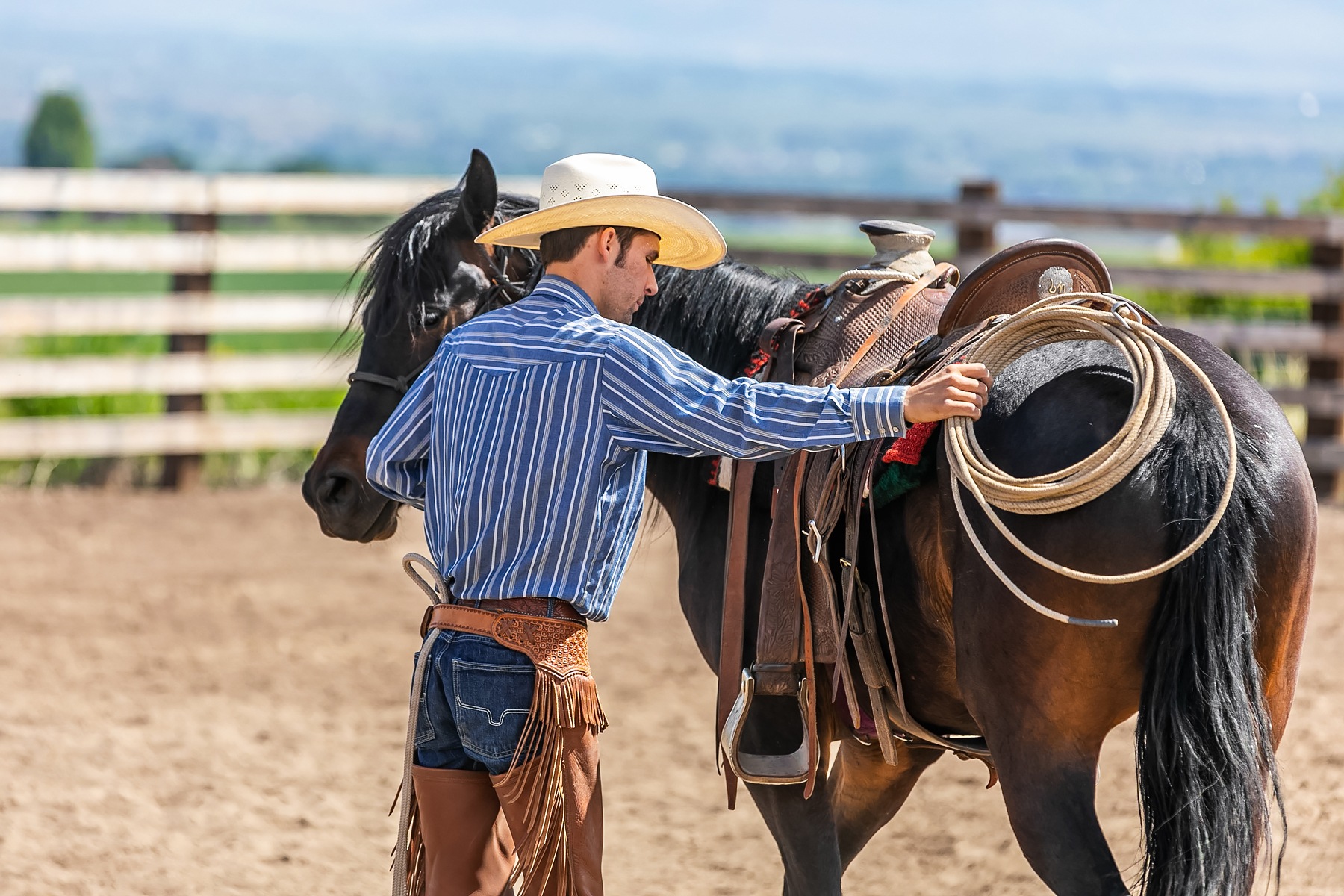
Nova’s Horror-mones
Nova has spent the entirety of her life here at SAFE. Her first breaths, steps, and moments were here on the farm, witnessed and overseen by the people who would go on to take care of her as she grew from a gangly filly into a long-legged mare. It is safe to say that we know Nova quite well.
When she entered her fourth year, Nova underwent a change in demeanor that was uncharacteristic. We first noticed it when she was getting her feet trimmed, something she was no stranger to, having seen the farrier every 6 weeks since she was a tyke. But at this visit, the brush of the farrier’s shoulder against her flank as she reached for a hind leg sent Nova into a tizzy. She was inconsolable from that point on, with every attempt to touch anywhere near her hind end resulting in a great deal of squealing and kicking.
This was behavior we had never before seen from Nova. Sure, she was at times a rambunctious young lady, still in the relative early days of her training, but we had not had any trouble brushing her rump, combing through her tail, or picking up her hind feet. But now, it was as though a switch had been flipped, and her rational mind was clicked off. And perhaps it was, in favor of something more base: hormones.
And said ‘horror-mones’ did seem to be the case. Nova’s season hit her hard and strong, clearly an unpleasant time for the lady, as well as for anyone who was tasked with handling her. We had our vets out to draw blood and see if the cause was, indeed, hormone-related, and if there was something more serious going on. When we first described the behavior to them, they wondered about the possibility of granulosa cell tumors, a common type of tumor to affect a horse’s ovaries, causing changes in demeanor. Blood work would help us pinpoint if that were the case.
When her results arrived, they showed that Nova’s testosterone was slightly elevated (normal range being 20 — 45 pg/ml), with Nova’s reading at 52.3 pg/ml. Because of this slight elevation, our vets recommended re-testing in 60 days, which would also coincide with fall, a time when her cycle should be breaking. If her testosterone levels were continuing to increase, it may be indicative of an early-stage tumor. However, when we drew blood for a recheck several months later, her testosterone was back in normal limits again, leaving our vets to believe that a granulosa cell tumor was not a concern at present. However, with her symptoms still in full force, they gave us the all clear to start Nova on Regumate to help try and suppress her cycle.
We were also curious if some of her reactivity was behavioral. We have had some experience with mares whose.. sensitivities, were not entirely related to things outside of their control. We were hopeful that in helping Nova understand that things touching her didn’t mean the sudden onslaught of a stallion, she could dismantle some of those intense reactions. And after a few days of consistent work, there did appear to be some changes happening — while still reactive at a rope or flag petting her hind, she was a bit less so, and she started each day a little more accepting than the day before.
Then, as we crept back into fall, something happened: Nova settled back into the mare we were more familiar with. She stopped having the same over sensitivity and reactivity to her hind end being touched. She allowed her back feet to be handled and trimmed again. All the while she looked at us with those sweet doe eyes of hers, as if to say, “who, me?” We were still cautious with her, but such a dramatic shift in her behavior seemed to belie that hers was, indeed, a seasonal problem above all else.
So as spring came back around, we shouldn’t have been so surprised that so did Nova’s tendencies towards the ‘kick now, think later’ approach. In this new year, we had also made the decision that Nova should have some time under someone else’s saddle, but when we loaded her in the trailer bound for our good friend Dylan’s training program, we sent the Regumate right along with her, hopeful it could play a nice second fiddle to the great work we knew Dylan would do with her.
And indeed, under Dylan, Nova continued to blossom into the lovely riding horse we had started to know her as. Her issues, for lack of a better term, seemed to be confined to her hind region, and over in Ellensburg, along with putting her through the normal paces, Dylan spent a great deal of time trying to help her through the sensitivities of her hind end.
Unfortunately, it did not appear that the Regumate was making significant changes in her demeanor. She was due for her annual dental, and we decided to have her more thoroughly checked out under sedation to ensure we hadn’t missed anything last time we’d drawn blood. Nova was seen by the folks over at Central Washington Equine Hospital, in particular by a Dr. Lindley, who was able to palpate her ovaries under sedation, where she found her left ovary to be significantly larger than her right. She once again drew blood to check for hormone changes, but when the results came back, they revealed that Nova’s testosterone was still in normal range. So the mystery as to why exactly her reactions to her heat cycles are so intense remains an ongoing puzzle that we continue to brainstorm ways to solve.
Nova has since returned from off-site training, and is back at SAFE where we are evaluating the next steps to take to help her feel her best (and stop trying to kick people, that too).

Nova’s Training Looks
Our lady Nova has been off at training for the last little while, and while we miss her tall, dark, and handsome self, we couldn’t be happier that she is getting a quality education under the blue skies of Ellensburg. Nova will likely always be a mare who is her best self when in regular work, so her time at training has been excellent for her in so many ways. Under Dylan’s tutelage, she is putting those long legs to good use, and making all kinds of positive strides under saddle.
More about the specifics of what Nova has been up to later. For now, I just want to share some beautiful photos that our good friend Candi K took of Nova at a recent visit. She sure is stunning to look at!
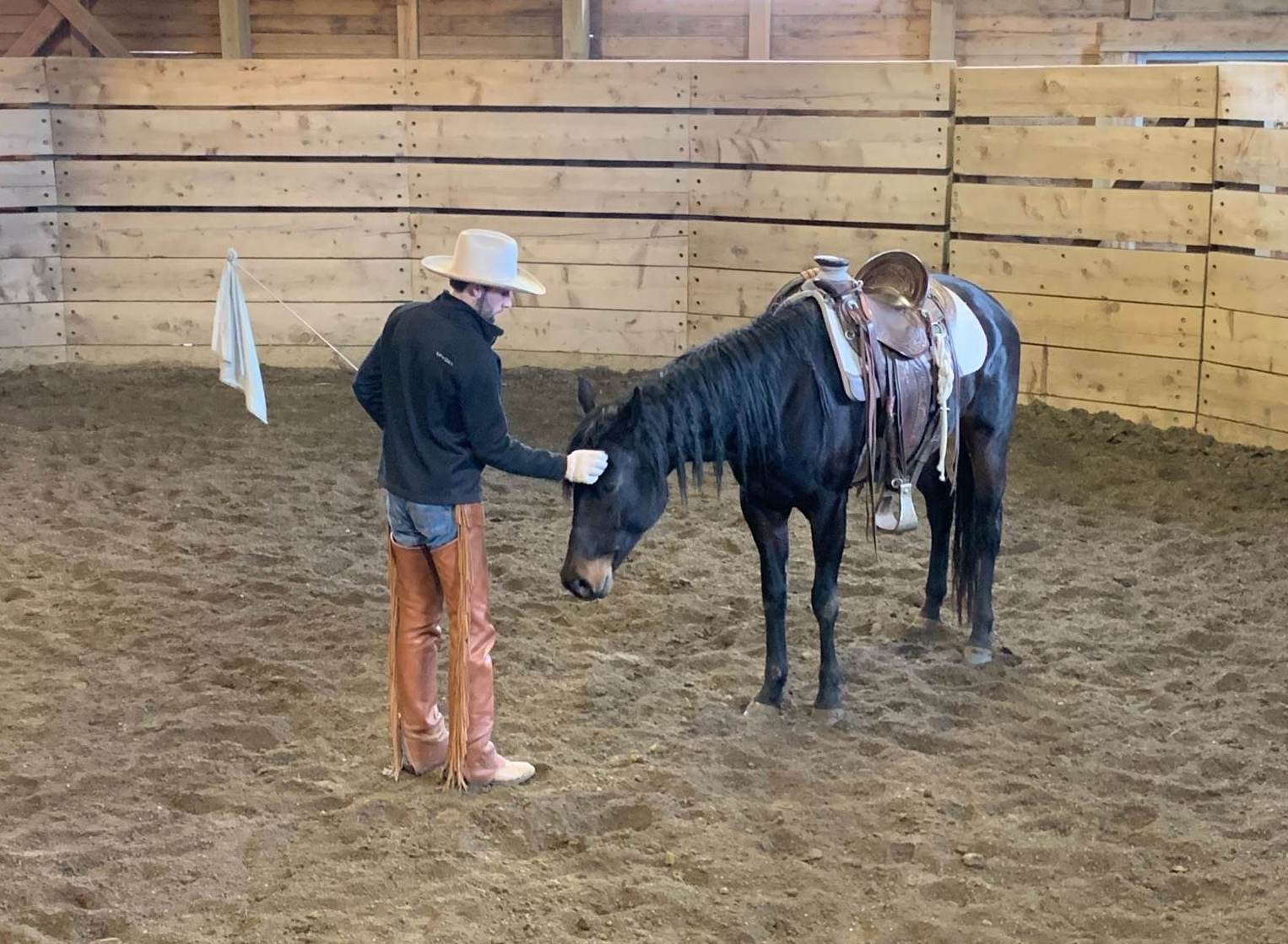
Nova at Training
What is that saying, girls go to college to get more knowledge? (I think there’s a part about boys in there too, but it’s a little less kind). The girl in question here is Nova, and the college is a place in Ellensburg with teacher, Dylan Palm. With a great start already under her belt, Nova has just been in need of a bit of dedicated time spent to really polish her to a shine, and we couldn’t think of a better place for her to spend a few weeks than with our old friend, Dylan. We are certainly missing her while she is away, but we are excited for the day she returns and she can show us, and potential adopters, all the old tricks she’s brushed up on and all the new tricks she’s learned.
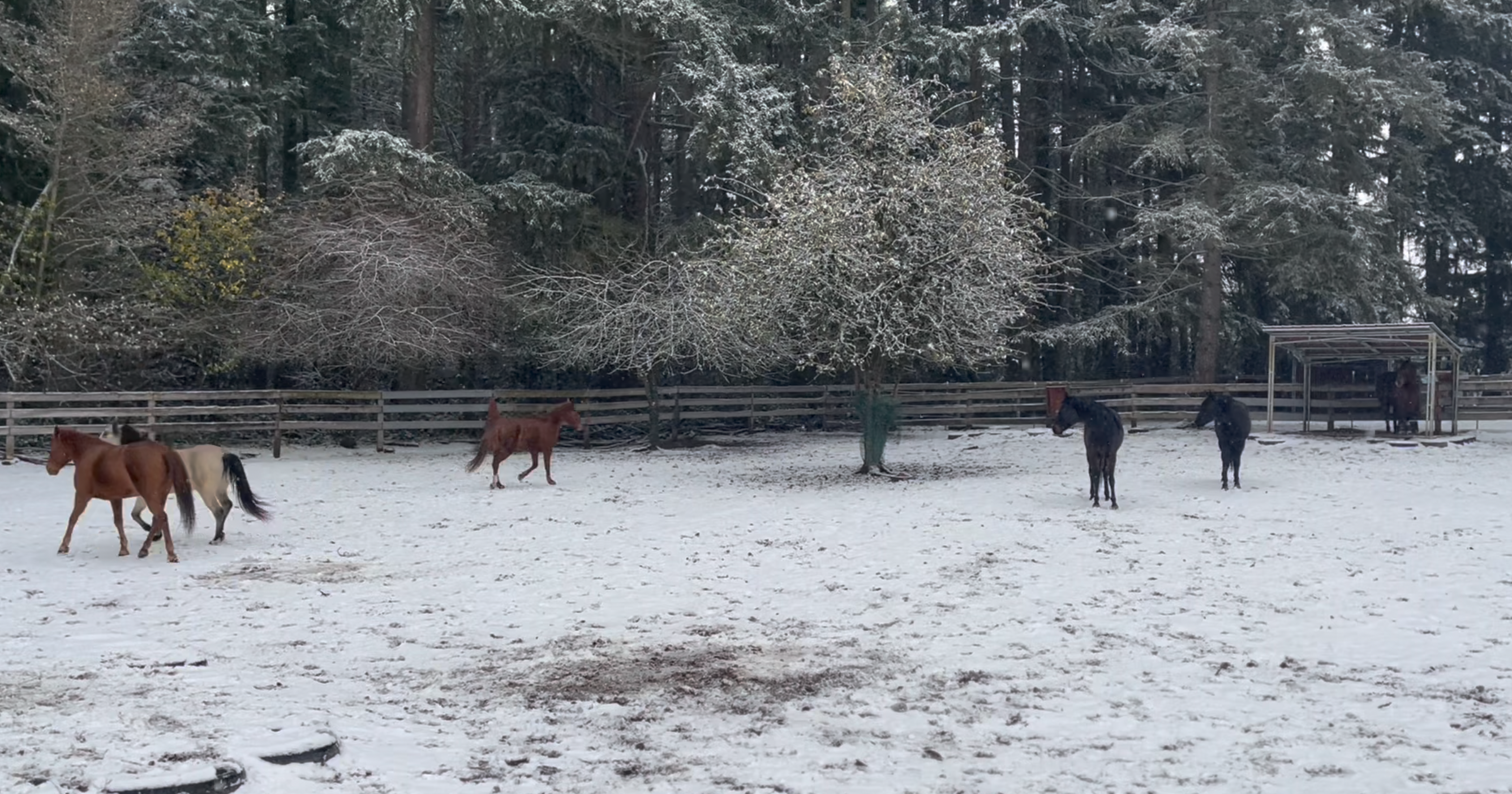
Herd your Horses
The nature of SAFE is that it is a transient place, meant to be a pause in the life of the horses who come here, a comma in their lives, not a full stop. What this means is that things change on a regular basis – we play musical paddocks quite often (though all of the horses have a chair at the end of it). What it also means is that herds grow and shrink as horses come and go.
For Nova, born on property, it is only to be expected that she has seen multiple shifts in her living situations. Over the summer, she was turned out with her fellow SAFE-born baby, Rae, and more recent addition, Valentine. The three enjoyed months of grass together and nights spent sleeping under the stars in what we colloquially call ‘the filly’s paddock. But Rae had a clinic to attend, pulling her from the group and into a separate space where she could quarantine upon her return, and Valentine found a home, leaving Nova without a herd.
But, as I said before, things never remain stagnant for long. We had intakes coming to SAFE who needed a place to land, which meant it was the perfect time to get a herd together – specifically, a mare herd.
Introducing horses is always a bit nerve wracking. As herd animals, they are born to work things out amongst themselves and establish a pecking order, but it certainly is difficult to remove the human emotion from the event. Our new mare herd would consist of 6 horses, all with different personalities and established roles in their own, smaller herds. There was bound to be a little drama. And there was, of course. Some kicks were aimed and some running was done, but everyone did, in the end, work it out, and we breathed a sigh of relief.
So – back to Nova. This herd, of which she is a part, includes:
her childhood friend, Rae, who she greeted with exuberance once they were re-introduced. Nova has always been the boss out of the two of them, and though she was clearly happy to see her friend, wasted no time in solidifying that dynamic between them.
Bijou, who Nova initially flocked to, the two of them getting into friendly spats over which hay box is the best one (“Oh you’re eating from there? Actually that’s the one I need to eat from!”).
Frosting, who despite being a youngster, has learned quite a bit about being the boss from Fancy, the herd’s current leader and Frosting’s long time friend. Frosting and Nova get along famously, and even though Frosting will pin her ears and Nova will squeal, the two have been seen snuggled up on multiple occasions.
These girls get up to daily shenanigans, mostly consisting of playing games of tag and making little plays for dominance. Other typical activities include rounds of ‘ring around the hay net’ and mid-day slumber parties.
Each morning at turn out, Nova gives a gleeful little buck as she runs off to join her friends at the haybox, encapsulating the way we all feel about watching a happy horse in a herd: yeehaw!
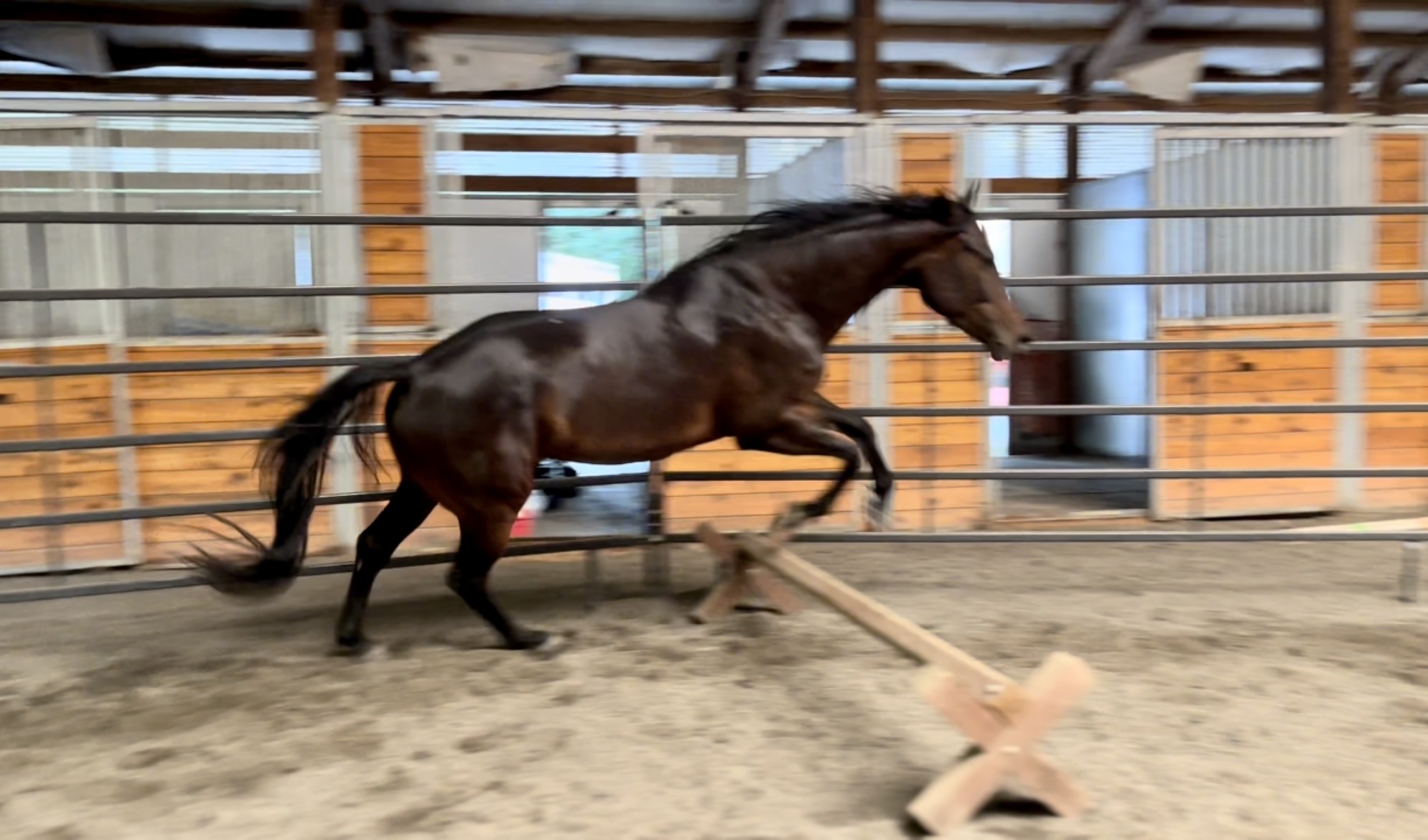
Training Update: Nova
Long-legged Nova will celebrate her 4th birthday this November. In the meantime, she has been working on her physique with some trot pole work. We think that Nova has it in her to really take on some fences one day, but for now, we will stick with cavalettis.

SuperNova
Nova is a tall drink of water. Or, perhaps a bit more appropriately, a tall drink of soda – something with bubbles, the kind that dance and pop above the glass, sparkly and effervescent. The word ‘coltish’ also springs to mind, certainly due to those long legs of hers, and the way it sometimes feels like she is still getting used to them. Not that she is ungainly, just that she possesses a looseness to her movements on occasion, much like a big puppy not yet done growing. And the comparison is apt – she is indeed a young thing still filling into herself.
For a while, she was getting turnout with Jill only – we rearranged the herd, and the two girls had a few weeks in a new paddock together. Even with a hay bag for each of them, they chose to eat together from one before moving to the next, Nova the taller of the pair often knocking alfalfa leaves into Jill’s mane.
Recently, however, they have been reunited with their old friend, Rae (in Nova’s case, the two of them were practically born together), and the trio have settled into their old routine of stretching their legs, napping in the sun, and testing the waters by moving each other around. They have also acquired some new fence neighbors – Pepper and Esme, who are quick to participate in the various dramas of teenage mares from the next paddock over, and Darla, who is a bit more aloof. With these fence introductions, the herd may be seeing an expansion soon, so stay tuned.
Nova, as a young, growing girl, has been given much of the winter off from work. Recently however, she’s taken some trips to the round pen again to reacquaint her with having her head in the game, so to speak. We worked on transitioning smoothly up and down through the gaits, as well as getting her ‘with me.’ Nova is a pretty mover, and although it takes her a moment, once she settles into a long trot or smooth canter, it is a pleasure to watch her. She requires lots of quick transitions to get her with you – leave her too long in one gait or another and you risk dulling her out. When sending a horse around, the goal is to make yourself as interesting as possible so they look to you for direction and connection. This is easier to accomplish with some horses, and Nova definitely challenges you to be a focal point. These transitions help to draw her attention and to keep it.
One of the biggest hurdles to overcome is maintaining her focus in a situation where it is being pulled elsewhere – most notably when she is separated from her friends. We have also added the joys of a young mare coming into season this year so the hormones are definitely in play now and an added element to working with her. In these scenarios, it is very difficult to draw her attention back from where it has been taken. The best way to go about doing so is by making the place where she wants to be – typically by the gate of the arena – more difficult, and the place where she does not want to be easy. This looks like: when she heads towards the spot she wants to be, making her “work” there, and then releasing all “work” once she turns towards the area she doesn’t want to be. “Make the wrong thing difficult and the right thing easy.” Easy in concept, harder to execute. Still, when she is ‘with you,’ working with Nova is a real joy.
As her training resumes in full this spring, it will be wonderful to continue to watch her grow (both physically and mentally), and I hope to have further opportunities to work with her.
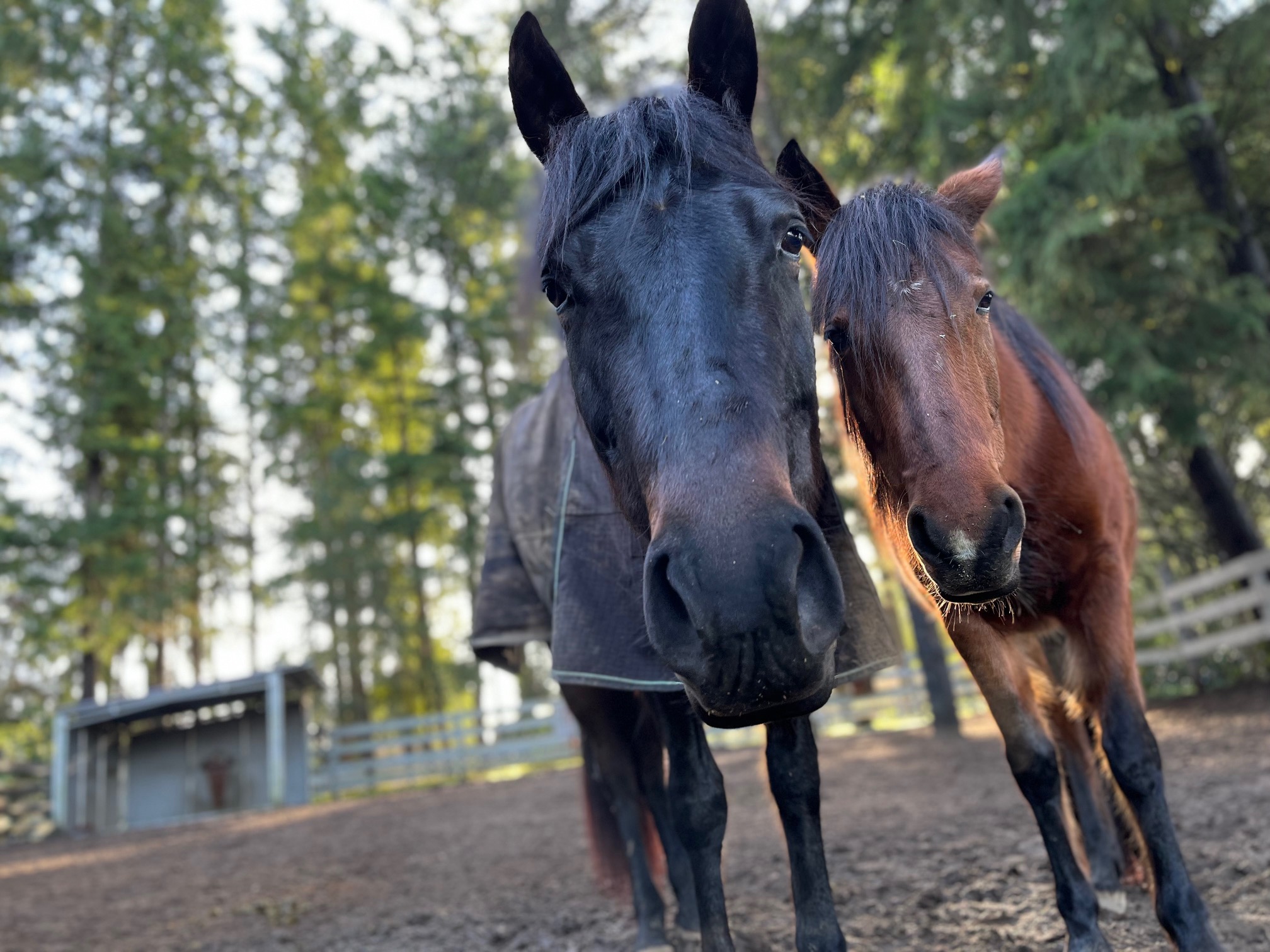
Nova and Jill Are Besties
Nova and Jill are enjoying each other’s company this winter. We have changed up the mare herd dynamics a bit and added a few of the older mares to a herd. Jill and Barb just wouldn’t “play nice” so some adjustments were made. Nova and Jill are the best of buds and it is pretty cute given their size difference to see them side by side in everything they do. Winter is moving along and in March we will be restarting Nova. As a 3.5‑year-old by then, she will go on the “payroll” and start enjoying more riding and experiences as an equine riding partner. We are looking forward to showing this lovely mare to potential adopters in 2022!

Our Growing Nova
Nova has started wearing a saddle! So far, it has only been a half dozen times because she is very sensitive and has a hard time with things above her head. She can be a bit over-reactive, so we are taking it slowly and giving her time. We are helping her even out by getting balance in her feet to feel more confident and secure. This will result in more confidence with a saddle and eventually with a rider. Our current plan is to have her first rides in the upcoming Joel Conner clinic in June. Over the summer, we will work with her lightly to develop her riding experiences without overworking her due to her young age.
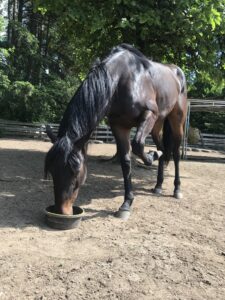 Nova is currently 15 hands tall with a lot of potential for more growth. In fact, she is growing so much, we have started giving her more grain to put some weight on. The staff has to stand and guard her “grain time” from the rest of the herd since she gets more than them. While she eats, she has a cute habit of picking up her right foot in the air and just holding it up while munching away. Sometimes she even creates a grain pan trail hauling it all around the paddock to keep the staff and volunteers on their toes. Nova is a growing into a gorgeous horse and is a friend to any new horse we add to her herd. We are excited to start her on the path to becoming a wonderful riding horse.
Nova is currently 15 hands tall with a lot of potential for more growth. In fact, she is growing so much, we have started giving her more grain to put some weight on. The staff has to stand and guard her “grain time” from the rest of the herd since she gets more than them. While she eats, she has a cute habit of picking up her right foot in the air and just holding it up while munching away. Sometimes she even creates a grain pan trail hauling it all around the paddock to keep the staff and volunteers on their toes. Nova is a growing into a gorgeous horse and is a friend to any new horse we add to her herd. We are excited to start her on the path to becoming a wonderful riding horse.

Nova, the Stunner
Nova is growing into a stunning young horse! She’s got legs for days and looks a lot like her mom. Nova is definitely lower on the filly totem pole than Pippi or Rae, but this little herd is all best of friends! When Jill joined the filly paddock, Nova was the only horse that welcomed her in, so Jill was attached to Nova at the hip for a while. Now though, if you look over toward the fillies, chances are you’ll see at least one random pair grooming each other, often you’ll see the whole herd of them piled up together! No filly ever drinks by herself, they go in at least sets of two to the water trough. It’s been so fun to watch them grow up and develop into their own little family.
Since Nova is now two years old, she’ll be entering our horsemanship program! More to come on this, stay tuned…

The Young Ladies at Play
Nova’s New Portrait
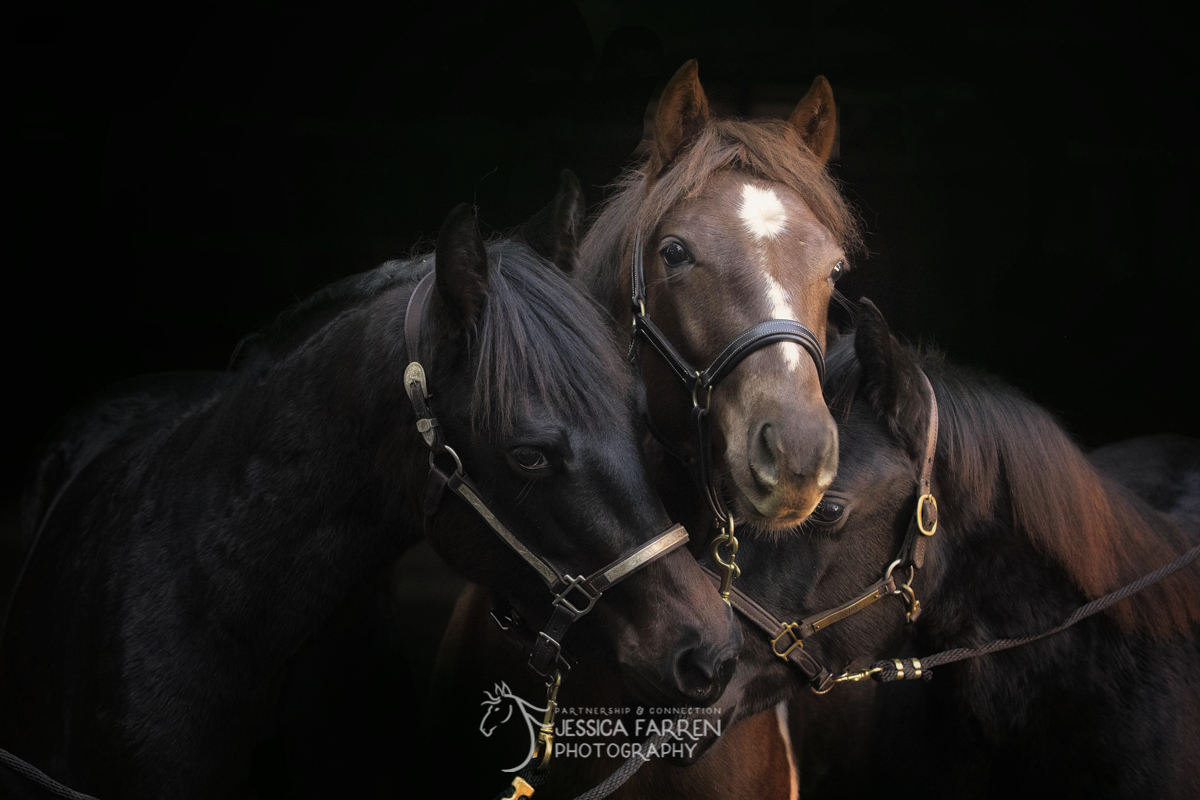
And Just Like That, They’re Yearlings!
It’s hard to believe that our three resident bundles of joy were born over a year ago! Nova, Rae, and Pippi have blossomed into beautiful young ladies, full of life and personality. We have enjoyed watching them grow and are looking forward to seeing what their futures hold. They’re leading well and standing patiently (usually) for their vet and farrier visits. They still have some “baby antics” that they use to try to see if they can get away with things, but they all seem very smart and figure things out quickly.
The trio are ready to fly the coop for now, and we’ll be sending them to foster soon where they can continue to grow up and learn how to be horses. Our current setup is not ideal with the number of volunteers we have that need to work around them in their pasture daily. The girls could gain bad habits from accidental reinforcement of pushy behavior, so we want to minimize that possibility. We have a foster home picked out and we just need to finalize a few things before sending them away to grow up.
It’ll be difficult to say goodbye, even though we know it’s only temporary. We’ve gotten used to being able to watch them grow up in our own backyard, so not seeing them every day will be a little sad at first. But it’s for the best, and we know they’ll enjoy their new place. Assuming all goes to plan, we’ll bring them back in about a year and a half to begin groundwork and working toward starting them under saddle.

The Babies are Growing Up!
It’s hard to believe how fast our little foals are growing up. It seems like just yesterday that they were trying to figure out how their legs work. Today they are three confident, adventurous, happy-go-lucky fillies who are ready to take on the world. And they’ve finally grown into those long legs.
All three babies have now finished their series of initial vaccines, had a few visits from the farrier, and know how to lead. They are enjoying being turned out in their large paddock 24/7, and they’re learning valuable lessons in equine behavior from their Aunt Renee and Aunt Angel. Renee teaches them boundaries and body language. Angel teaches them about kindness. And together, Angel and Renee teach lessons in herd dynamics and what it means to be a good friend.
We have enjoyed getting to know their little personalities. Each of them is an individual and very different from the other two. Pippi is the clear leader of the baby pack. She is the most confident of the three foals when it comes to exploring new things and meeting new horses. Renee is doing a good job of keeping her in line, as she does get a little pushy with the other horses. Pippi and Angel have become very close friends. You’ll often find the two of them snuggled up close and sharing a haynet.
Nova is darling. She’s tall and beautiful, just like her mom. She has a sweet, dainty personality and enjoys people, although she can be leery of new things at first. Out of the three babies she is the least self-assured and that’s how it’s been since the day she was born. But her confidence is growing. She’ll stand quietly to have her feet trimmed, she’s leading well, and she tolerates being dewormed (preferably if it’s followed by applesauce).
Rae is as cool as they come. She’s easygoing about everything, loves everyone, gets along great in a herd, and has a very laid back outlook on life. Nothing seems to bother her too much. She has her mother’s gentle nature and enjoys human interaction. It took Rae a while longer than the others to fully shed her baby fuzz, and for a while she was the “very cute but kind of goofy looking” one. But today she is a stunning, dark, shiny filly. She’s the smallest of the three, and we do not expect her to reach the same mature height as her 15.2hh dam.
Raising three foals has been a laborious, expensive journey, and it’s definitely not something we would have chosen to do if this situation hadn’t been handed to us already in the works. But these babies have been delightful additions, and we look forward to seeing what kinds of horses they grow up to be.

Three Weaned Babies
It took some work and a fair amount of brainstorming, but we weaned all three babies over the course of about a week and a half. First Nova, then Rae, and finally Pippi. Even though Pippi is two months older than Nova and Rae, we opted to wean her last based on herd dynamics, the personalities of all the mares involved, and space available. Each of the weanings was relatively uneventful, and the little amount of drama that accompanied each one was over within an hour or two (with Nova’s weaning there wasn’t much fuss at all). Pippi seemed to take it the hardest, but having her new buddies Rae and Nova there for comfort made a big difference. Nova seemed more upset about losing her aunt Mina than she was about being separate from her own mother.
The three fillies are now hanging out with matriarchs Angel and Renee. They’ll be learning lessons about how to be a horse from these ladies who have been there and done that. At some point in the near future we’ll send them to foster where they’ll be able to grow up in a quiet place with room to romp, and we’ll bring them back when they’re 2‑year olds to start introducing them to groundwork in preparation for becoming riding horses. For now, though, we are happy to have them right where they’re at because they’re a constant source of amusement. No doubt about it, though, raising babies is a lot of work!
- Asha meeting new neighbor, Gunnar
- Mina enjoying the peace and quiet of not having a baby at her side
- Luna explores her new paddock
- Grain tastes best after you dump it
- Triangulation

Sunshine!
It’s hard to believe that just over a month ago it was 13 degrees at Safe Harbor Stables, and this week the thermostat is hitting 80! The horses are enjoying it tremendously and taking every chance they can to sun bathe.
The downside to this beautiful weather is that horses still wearing their winter coats can dehydrate quickly when it’s hot outside. We’ve been keeping a close eye on ours to make sure they aren’t getting overheated. Provide access to fresh, clean water for your horses at all times–and monitor to make sure they’re actually drinking it.
Welcome, Spring! We’re all happy to see you.
- Mina and babies
- Kat
- Luna and Nova
- Asha and Pippi
- Angel

Why are there foals at SAFE?
Why are there foals at SAFE right now? Because this year, we rescued three mares who were pregnant. We have not changed our stance against breeding, nor did we have anything whatsoever to do with the breeding of these mares.
One of the three mares, Asha, came from an Animal Control seizure in which she and another mare were removed from a situation of neglect and starvation. Her foal was born Sept 1, so she was likely bred in October 2017. This mare was seized by Animal Control on Jan 30, 2018 and was signed over to SAFE on April 15, 2018.
The other two mares, Luna and Mina, came from a large band of 21 horses (including 9 stallions) who were roaming free on a property that was foreclosed upon and resold. These mares gave birth on Nov 1 and Nov 3, which means they were bred in December 2017. We were brought in by Animal Control to help disperse this herd in April 2018. Because they were exposed to stallions, we had to assume that all the mares in the herd were pregnant when we took them, and this was confirmed by veterinarians after they were rescued.
Furthermore, whenever we intake a colt or stallion, that animal is gelded as soon as it is physically possible to do so, and usually before the horse even comes to our farm. The only intact stallion to ever set foot on our farm in Redmond was Valor. He was gelded on August 9, 2017.
So, to recap:
1) SAFE does not breed horses
2) SAFE does not keep intact colts or stallions
3) SAFE does, however, rescue pregnant mares
If you or anyone you know has questions about SAFE and the work we are doing, please ASK. We operate 100% in the public eye, so if there’s something you’re curious or concerned about, just ask. It’s that simple.
Now let’s get back to enjoying those beautiful babies!
Luna and Nova Get Outside
Jessica Farren took these lovely photos of Luna and her filly Nova. The two spend most of each day outside on the grass where Nova loves to run and run and run!

Two Healthy Fillies Born at SAFE
Exactly two months after the birth of Pippi, we welcomed two new lives into the world!
Mina delivered a lovely black filly on November 1, 2018 at 11pm. The diminutive little girl with no white markings was christened “Rae” in memory of our dear friend Raven. Rae is healthy and full of life, and momma Mina is taking wonderful care of her.
The very next night, Luna decided she was going to follow in her best friend’s footsteps and have her baby too. She waited until 2:30am to give birth to a tall strapping bay filly that has been named Nova. The delivery went well, and both mom and baby are healthy.


